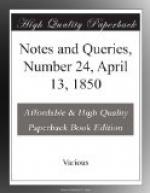Why is an Earwig called a “Coach-bell?"—Your correspondents, although both kind and learned, do not appear to have given any satisfactory answer to my former query—why a lady-bird is called Bishop Barnaby? Probably there will be less difficulty in answering another entomological question—Why do the country-people in the south of Scotland call an earwig a “coach-bell?” The name “earwig” itself is sufficiently puzzling, but “coach-bell” seems, if possible, still more utterly unintelligible.
LEGOUR.
Chrysopolis.—Chrysopolis is the Latin name for the town of Parma, also for that of Scutari, in Turkey. Is the etymological connection of the two names accidental? and how did either of them come to be called the “Golden City?”
R.M.M.
Pimlico.—In Aubrey’s Surrey, he mentions that he went to a Pimlico Garden, somewhere on Bankside. Can any of your correspondents inform me of the derivation of the word “Pimlico,” and why that portion of land now built on near to Buckingham House, through which the road now runs to Chelsea, is called Pimlico?
R.H.
April 1. 1850.
Zenobia.—I have read somewhere that Zenobia, Queen of Palmyra, was of Jewish origin, but am now at a loss to retrace it. Could any of your correspondents inform me where I have read it?
A. FISCHEL.
Henry Ryder, Bishop of Killaloe.—“W.D.R.” requests information in reference to the paternity of Henry Ryder, D.D., who was born in Paris, and consecrated Bishop of Killaloe in 1692.
Belvoir Castle.—In the Harleian Miscellany, vol. iv. p. 527., is a Pindaric Ode upon Belvoir Castle, which Mr. Nichols reprinted in his History of the Hundred of Framland. Can any of your readers inform me who was the author of this very singular production?
T.R. Potter.
St. Winifreda.—Can any of your readers refer me to any history or recent discoveries relative to St. Winifreda?
B.
Savile, Marquis of Halifax.—It is stated in Tyers’s Political Conferences (1781), that a Diary of his was supposed to be among the Duke of Shrewsbury’s MSS.; and when Mr. Tyers wrote, in the hands of Dr. Robertson. Can any of your readers give information about this Diary?
C.
Salt at Montem.—Will you allow me, as an old Etonian, to ask the derivation of “salt,” as it used to be applied to the money collected at Eton Montem for the Captain of the Colleges? Towards investigating the subject, I can only get as far as Salt Hill, near Slough, where there was a mount, on which, if I remember rightly, the Captain waved a flag on Montem day. A brief account of the origin of Montem would be interesting; and it is especially worth noting now that the pageant is suppressed.
A.G.
Ecclesfield, March 14, 1850.




